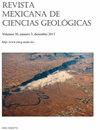Profundidad del Punto de Curie y Flujo Térmico en la Zona de Cuencas Offshore de Argentina
IF 0.5
4区 地球科学
Q4 GEOSCIENCES, MULTIDISCIPLINARY
Revista Mexicana De Ciencias Geologicas
Pub Date : 2020-03-31
DOI:10.22201/cgeo.20072902e.2020.1.1038
引用次数: 1
Abstract
In order to know the thermal distribution and its relationship with tectonic structures studies were conducted in front of the Argentine coast, in the area corresponding to the platform, slope and abyssal plain, in the region ranging from 50° to 66° West and 36° to 50° South. Fourier analysis of the potential fields allows us estimating the Curie point depth (CPD). The variation of the depth to the Curie point is an indicator of lithospheric thermal anomalies, some of which would be associated with variations in lithospheric thickness linked to the phenomena that took place during the separation of the Gondwana continent and opening of the South Atlantic Ocean, such as basins and transfer zones. Maps of Curie point depth and thermal flow were made. These maps were correlated with an isostatically compensated crust 3D model and a crust-upper mantle discontinuity depth 3D model, calculated by gravimetric inversion. This comparative analysis allowed us to interpret tectonic structures, crustal thickness and isostatic decompensation degree on the study area. Higher depths to the Curie point were obtained in the continental crust zone (between 30 and 15 km, approximately) than in the oceanic zone (between 25 and 10 km, approximately). On the continental crust, the shallowest values were found in the offshore basins sectors, in the oceanic crust, the deepest values are below the crust-upper mantle discontinuity level. Profundidad del Punto de Curie y Flujo Térmico en la Zona de Cuencas Offshore de Argentina Guillermo Domingo Pizarro1,2,*, Francisco Ruiz1, María Alejandra Arecco3,4 y Marta Ghidella5 1 Universidad Nacional de San Juan (UNSJ), Facultad de Ciencias Exactas, Físicas y Naturales, Instituto Geofísico-Sismológico Ing. F. Volponi (IGSV), Ruta 12, km 17, C.P. 5407, Jardín de los poetas, Marquesado, Rivadavia, San Juan, Argentina. 2 Universidad Nacional de San Juan (UNSJ), Facultad de Ciencias Exactas, Físicas y Naturales, Departamento de Biología, Av. Ignacio de la Roza 590 (O), C.P. 5400, Rivadavia, San Juan, Argentina. 3 Universidad de Buenos Aires, Facultad de Ingeniería, Instituto de Geodesia y Geofísica Aplicadas, Av. Las Heras 2214, 3er piso, C.P. C1127AAR, Ciudad Autónoma de Buenos Aires, Argentina. 4 Universidad de la Defensa Nacional, Facultad de la Armada, Escuela de Ciencias del Mar, Av. Antártida Argentina 425, C.P. C1104ACA, Ciudad Autónoma de Buenos Aires, Argentina. 5 Ministerio de Relaciones Exteriores y Culto, Cancillería Argentina, Instituto Antártico Argentino, 25 de mayo 1143, C.P. B1650HMK, San Martín, Provincia de Buenos Aires, Argentina * guillepizarro@hotmail.com REVISTA MEXICANA DE CIENCIAS GEOLÓGICAS v. 37, núm. 1, 2020, 26-39 I: htt ://dx.doi.org/10.22201/cgeo.20072902e.2020.1.1038 27 CPD en el Offshore de Argentina RMCG | v. 37 | núm. 1 | www.rmcg.unam.mx | DOI: http://dx.doi.org/10.22201/cgeo.20072902e.2020.1.1038 Offshore basins are associated with lithospheric thinning accompanied by thermal anomalies indicated by elevations of the CPD. The oceanic basement would be linked to descending asthenospheric currents that produce an increase in its depth and CPD. The isostatic model shows a deeper mantle than the gravimetric one in sectors of offshore and shallow basins in the oceanic crust zone. The isostatic model shows a deeper mantle then the gravimetric one in the offshore basins sectors and shallower in the oceanic crust zone.阿根廷海上盆地带居里点深度和热通量
为了了解阿根廷海岸前的热分布及其与构造构造的关系,在西经50°~ 66°和南经36°~ 50°的台地、斜坡和深海平原对应区域进行了研究。对位场进行傅里叶分析可以估计出居里点深度(CPD)。到Curie点的深度变化是岩石圈热异常的一个指标,其中一些可能与岩石圈厚度的变化有关,这些变化与冈瓦纳大陆分离和南大西洋开放期间发生的现象有关,例如盆地和转移带。绘制了居里点深度图和热流图。这些地图与均衡补偿的地壳三维模型和地壳-上地幔不连续深度三维模型相关联,通过重力反演计算。通过对比分析,对研究区构造构造、地壳厚度和均衡补偿程度进行了解释。大陆地壳带的居里点深度(大约在30至15公里之间)比大洋带的深度(大约在25至10公里之间)要高。在大陆地壳上,最浅的值出现在近海盆地部分,在海洋地壳上,最深的值出现在地壳-上地幔不连续层以下。1阿根廷圣胡安国立大学(UNSJ),科学技术学院Físicas,自然科学研究所Geofísico-Sismológico . guencas Offshore Zona Guillermo Domingo pizarro1,2,*, Francisco Ruiz1, María Alejandra arecco3,4, Marta Ghidella5。阿根廷圣胡安,里瓦达维亚,马奎萨多,圣胡安国立大学(UNSJ),精确科学学院Físicas,自然学系Biología,伊格纳西奥·拉·罗萨590 (O), C.P. 5400,里瓦达维亚,阿根廷圣胡安。3布宜诺斯艾利斯大学,学院Ingeniería,测绘研究所Geofísica应用,Las Heras 2214, 3er piso, C.P. C1127AAR, Autónoma布宜诺斯艾利斯,4阿根廷国立国防大学,舰队学院,马尔科学学院,大道Antártida阿根廷425,C.P. C1104ACA,阿根廷布宜诺斯艾利斯市Autónoma . 5阿根廷对外关系部,Cancillería阿根廷,Antártico阿根廷研究所,五月25日1143,C.P. B1650HMK,圣Martín,阿根廷布宜诺斯艾利斯省* guillepizarro@hotmail.com墨西哥科学研究刊GEOLÓGICAS v. 37, núm。石油学报,2020,26-39 [j]: http://d.wanfangdato.com.cn/details/detail.do?1 | www.rmcg.unam.mx | DOI: http://dx.doi.org/10.22201/cgeo.20072902e.2020.1.1038海上盆地与岩石圈变薄相关,伴随着CPD升高所指示的热异常。海洋基底与下降的软流层流有关,软流层流会增加其深度和CPD。在洋壳带的近海和浅海盆地部分,均衡模型显示出比重力模型更深的地幔。均衡模型表明,近海盆地板块的地幔较重地幔深,洋壳带的地幔较浅。
本文章由计算机程序翻译,如有差异,请以英文原文为准。
求助全文
约1分钟内获得全文
求助全文
来源期刊

Revista Mexicana De Ciencias Geologicas
地学-地球科学综合
CiteScore
1.00
自引率
12.50%
发文量
0
审稿时长
6-12 weeks
期刊介绍:
Revista Mexicana de Ciencias Geológicas (RMCG) publishes original research papers on geological processes of broad interest, and particularly those dealing with regions of Latin America. The RMCG also publishes review papers on topics of current interest, and on the geology and tectonics of geological provinces of Latin America. Besides, it offers the opportunity for host editors to publish special thematic issues.
 求助内容:
求助内容: 应助结果提醒方式:
应助结果提醒方式:


